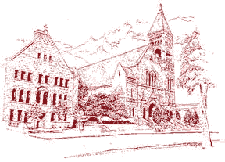
Construction workers 1890
Immigrants
The story of our cathedral parish is rooted in immigration. As the land now called Iowa became home to a flood of people seeking a new life and opportunity, the Catholic Church has done its best to serve their material and spiritual needs. When the cathedral was built in 1890, immigrant laborers were at the heart of the work.
For more than five decades, this parish has made special efforts to welcome refugee immigrants. Sr. Pat Sherer, followed by Fr. Ambrose Ladu Daniel, have led Refugee Ministry on the parish staff. The relationships they formed, plus our faith life together as community, has formed St. Ambrose into a uniquely diverse and unified parish.

Latin inscription on cornerstone translates: ``Praise the Lord, all you nations!``
1970s to present
There are approximately 600 households registered at St. Ambrose today. This includes a majority of immigrant families, and our ethnic and cultural diversity has changed over the years.
Iowa was a leader in welcoming refugees about the time of the fall of Saigon in 1975, at the end of the Vietnam War. Many Southeast Asians sought refuge in the United States, including at St. Ambrose in Des Moines. Sr. Pat Sherer began fulltime refugee ministry in the parish in 1982
Years later, waves of refugees from Africa and Myanmar (Burma) have made this their home. Smaller numbers from other countries, including Hispanic immigrants, have further diversified our faith community.

1970s-1980s
Vietnamese people began arriving at St. Ambrose in the 1970s. Most of them came as “boat people” in the 1980s and early 1990s. Some passed through the Philippines, Singapore and Hong Kong. One of them, Deacon Joseph Huynh Van Ngoc, became a leader at St. Ambrose working with hundreds in the Cathedral’s Vietnamese Community. On Sunday Nov. 30, 2008, Bishop Pates designated a parish for the Vietnamese at St. Peter’s with Fr. Ly Chu as pastor.
Lao and Hmong from Laos began arriving at St. Ambrose in the mid-1970s, reaching their peak in 1980. By 1983, the new arrivals had stopped. An estimated 200 became parishioners. They left Laos because they had worked and fought with Americans during the War. They fled from Laos to Thailand and, working with resettlement agencies, came from there to the U.S. In 2023, there are approximately thirty Lao and twenty Hmong families at St. Ambrose.
Cambodians were among the Southeast Asian refugees during these years, but because Cambodia was a Buddhist country, very few of the refugees came to the Catholic Church. Of the perhaps ten to twenty individuals once at St. Ambrose, only a few became Catholic with one of them remaining in 2023.
1990s to present
Refugees from Sudan began to arrive in the 1990s. In 1983, war started in that country, including persecutions and torture. The first refugees arrived at St. Ambrose in 1992-1993 (via Ethiopia) and were mostly non-Arabic speakers. Later in the 1990s, many more arrived who were mostly Arabic speaking. They came via Egypt, Lebanon and Kenya. Francis Chan came with his family in 2000. He was ordained a permanent deacon for the Des Moines diocese in 2008.
Over time, approximately 2000 to 3000 from Sudan have been at St. Ambrose, many attracted by the presence of Sr. Pat Scherer, then the refugee coordinator, and Dcn. Francis. Many moved to Omaha in 2002-2003. Now in 2023, there are approximately 200-300 Sudanese and South Sudanese at St. Ambrose, and a few new arrivals continuing to come.
Kunama-speaking Eritrean refugees first arrived at St. Ambrose in 2008. There have been wars for many years in Eritrea. Refugees came to Des Moines via Ethiopia, initially, because of work here in meat processing plants. Later, more arrived because of family members already at St. Ambrose. There are, reportedly, 250 to 300 Kunama at St. Ambrose in 2023 and new arrivals continue. Eritreans who speak other languages are also part of our parish.
2008 to present
There have been wars in Myanmar (formerly Burma) for decades, many involving non-Burmese-speaking groups. In 2008, eight households of Burmese refugees arrived at St. Ambrose. They began meeting and praying the rosary in the chapel on Sunday mornings. As more came, the Burmese Community at St. Ambrose divided into three groups so they could pray in their own language: Karenni, Zomi and MCC (Myanmar Catholic Community). Some of these parishioners came through refugee camps in Thailand, but others came via Malaysia and India. Many continue to come. There are approximately 500 Karenni, 200 Zomi and 80 MCC parishioners in 2023.

Praise the Lord, all you nations!
Extol him, all you peoples!
His mercy for us is strong; the faithfulness of the Lord is forever. Hallelujah!
Psalm 117
Credits: Thank you to those who were interviewed in Oct. 2023 for information about their communities at St. Ambrose: John Huynh, Samol Thlang, Dcn. Francis Chan, Jafar Kini, Mose Kima, Martin Nawl, Dcn. Ly Chao and Iem Phrasany. This summary is incomplete: a first-attempt to record this information. Perhaps, in time, members of the ethnic communities may write their own parish experiences.


